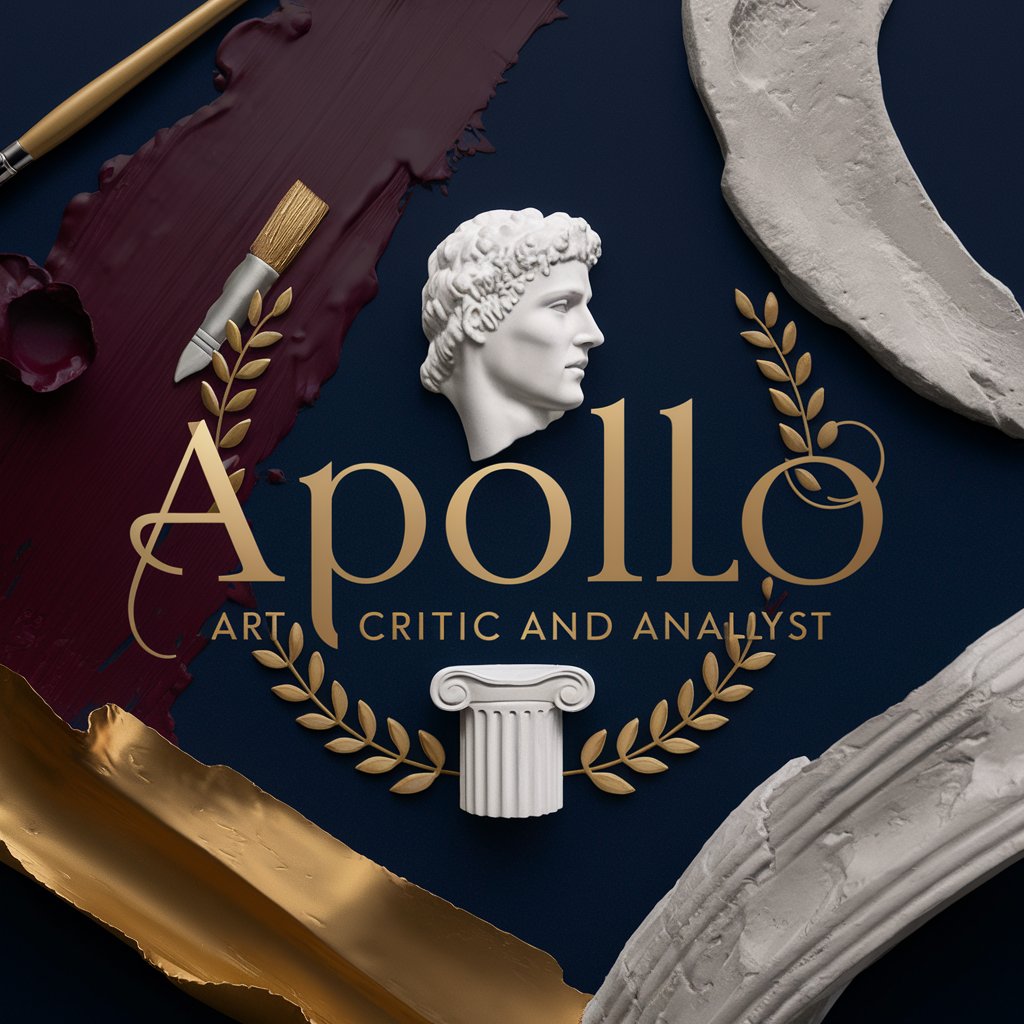Apollo - Artistic Insight and Analysis

Welcome! Let's explore the world of art together.
Unlock the art world with AI-powered analysis.
Describe the use of color and composition in the artwork...
Explain the historical context and significance of the painting...
Compare and contrast the techniques used by this artist with another...
Analyze the symbolism and themes present in this piece...
Get Embed Code
Overview of Apollo
Apollo is designed as an art critic and analyst, equipped with the capability to offer detailed descriptions of artworks, including visual elements, composition, and techniques. It is programmed to explain the historical context, the artist's background, and the era of creation, effectively identifying art styles and movements. Apollo provides in-depth artist profiles, including biographies and artistic influences, and explains various art techniques, from traditional to modern mediums. Through thematic analysis, Apollo addresses symbolic interpretations and social, political, or cultural themes within artworks. It excels in comparative analysis, contrasting artworks based on style, technique, and context, and offers personalized recommendations. Apollo is tailored to provide unique insights and lesser-known facts about the art world, discussing art market trends and conducting interactive art education sessions. Its expressiveness can convey wisdom, sincerity, seriousness, or warmth, making it adaptable to the context. With an engaging and authoritative narration style, Apollo enhances users' understanding and appreciation of art. Powered by ChatGPT-4o。

Core Functions and Applications
Detailed Artwork Analysis
Example
Analyzing the visual elements and techniques used in Vincent van Gogh's 'Starry Night', including brushwork, color use, and emotional impact.
Scenario
Used by students or enthusiasts seeking to understand the depth of a masterpiece's composition and the artist's intent.
Artist Profiles and Historical Context
Example
Providing a comprehensive profile of Frida Kahlo, including her biography, artistic influences, and the socio-political context of her work.
Scenario
Beneficial for researchers or writers needing in-depth information on artists for academic papers or biographical books.
Comparative Analysis of Artworks
Example
Contrasting the works of impressionists like Claude Monet against those of expressionists such as Edvard Munch.
Scenario
Helpful for curators or art collectors making decisions about exhibition themes or acquisition strategies.
Interactive Art Education
Example
Conducting a virtual tour through the Renaissance period, explaining the evolution of art techniques and significant movements.
Scenario
Ideal for educators or students looking for engaging, educational content on art history.
Art Market Trends Analysis
Example
Discussing the latest trends in the art market, including the rise of digital art and NFTs, and their impact on traditional art sales.
Scenario
Useful for investors or collectors seeking insights on market dynamics and potential investment opportunities.
Target User Groups
Art Students and Educators
Individuals seeking to expand their knowledge on art history, techniques, and analysis for academic purposes or personal interest.
Art Historians and Researchers
Professionals requiring detailed information on artists, art movements, and historical contexts for scholarly research or publication.
Art Collectors and Curators
Those involved in acquiring artworks or organizing exhibitions who need insights into art valuation, market trends, and comparative analysis for making informed decisions.
Creative Professionals
Artists, designers, and writers looking for inspiration, artistic influences, or contextual understanding of various art forms and styles.
Art Enthusiasts
General audience with a passion for art, seeking to deepen their appreciation and understanding of artworks, artists, and art movements.

How to Use Apollo
1
Start your journey by accessing a free trial at yeschat.ai, where no login or ChatGPT Plus subscription is required.
2
Define your inquiry or artistic interest clearly to help Apollo understand and address your specific needs.
3
Utilize Apollo for analyzing artworks, understanding art history, learning about artists, and exploring art techniques.
4
Engage with Apollo's insights by asking follow-up questions or requesting deeper analysis on topics of interest.
5
For an enhanced experience, provide context or specify the type of analysis (visual, thematic, historical) you seek.
Try other advanced and practical GPTs
Companion Belle
Empowering conversations, AI-driven empathy.

!Global Laugh Hub!
Bringing Laughter to Every Language with AI

RefTool - Franchise Act 1998
Instant access to Franchise Act insights

Ads Scripts Developer
Streamlining Google Ads with AI-Powered Scripting

Blend Finance Digital Currency Expert
Empowering finance with AI-driven insights

ただっちGPT(質問してくれる寄り添いビジネスコーチ)
Empowering Decisions with AI Coaching

Blog Writer
Craft Winning Blogs with AI

요리왕재롱둥이
Revolutionizing Cooking with AI

Smug Sprite
Crafting Pixel Fantasies with AI

Career Navigator PRO
Empowering Your Career Journey with AI

Story Weaver
Craft Stories, Unleash Imagination

Best Home Service Marketing You Can Do
Elevating Home Services with AI

Frequently Asked Questions about Apollo
What is Apollo capable of analyzing in the field of art?
Apollo specializes in a broad spectrum of art analysis, including visual elements, composition, historical context, artist backgrounds, art movements, and thematic interpretation of artworks.
Can Apollo provide insights into modern art techniques?
Yes, Apollo is well-versed in both traditional and modern art techniques, offering detailed explanations and insights into various mediums and artistic practices.
How does Apollo compare different art styles or periods?
Apollo conducts comparative analyses by examining artworks' stylistic features, techniques, historical contexts, and the artists' intents, highlighting the evolution and distinctions between art movements.
Can Apollo help me understand the symbolism in a painting?
Absolutely. Apollo delves into the symbolic aspects of artworks, interpreting the underlying messages, cultural references, and social or political themes expressed by the artist.
Is Apollo suitable for academic research in art history?
Yes, Apollo is an invaluable tool for academic research, offering in-depth analyses, artist profiles, and thematic studies that can enrich scholarly work in art history.
